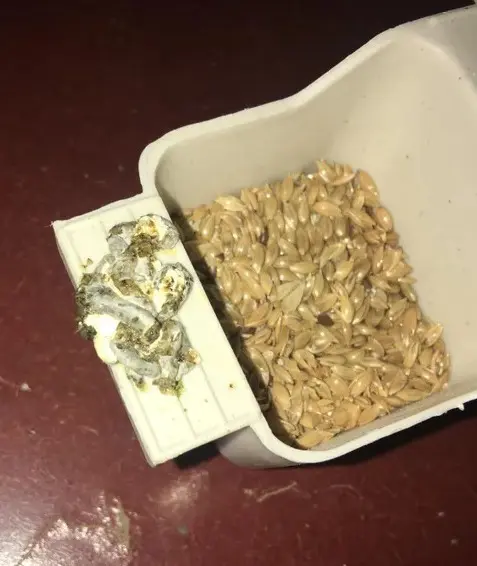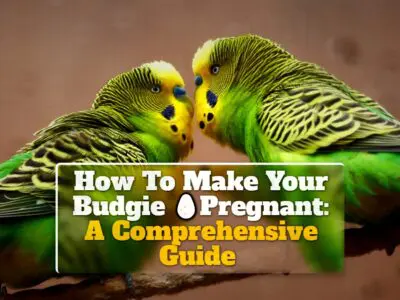Observing your budgie’s behavior, appetite changes, nesting habits, physical changes like an enlarged abdomen, changes in droppings, and weight fluctuations can hint at egg-carrying.
Still, an avian vet should confirm it.
Being a bird lover and ex-budgie owner, I often encountered the question, “How can I tell if my budgie is pregnant?”
Whether budgies can carry eggs or not is more commonly referred to in laymen’s terms as pregnant.
Unraveling the signs of a budgie pregnancy can be a bit of a challenge, necessitating careful observation and a good understanding of budgie behavior.
Over the years, from my experiences, readings, and observations, I’ve picked up on some potential signs.
However, keep in mind that they’re not foolproof, and other health issues can manifest similarly.
So, a vet’s advice is paramount.
This content is aimed at helping budgie owners get more insight into their pets’ behaviors and health.
Changes in Behavior
The way a budgie behaves can often be a tell-tale sign of their health and well-being, including whether or not they are carrying eggs.
During such a time, budgies often exhibit a series of behavioral shifts that may appear subtle at first, but with keen observation, they can be easily spotted.
You, as the caretaker, need to be vigilant about these changes, as they can provide crucial information about the status of your budgie.
Changes in Appetite
A pregnant budgie’s appetite often fluctuates, becoming a critical sign of their condition.
You might find your budgie eating more than usual, a response to the increased nutrient needs of developing eggs.
On the other hand, your budgie might also eat less, a potential result of discomfort or space constraints in the abdomen due to egg development.
Be sure to observe changes in the amount of food intake and the frequency of their meals.
But remember, changes in appetite can also be signs of health issues unrelated to egg-laying.
Increased Territorial Behavior
During pregnancy, a budgie’s territorial instincts might amplify.
Usually sociable, your feathered companion may start showing increased aggression towards cage mates or even you, especially around their chosen nesting area.
This heightened defensive behavior is an instinctual measure to protect their future eggs and chicks.
If you notice your usually friendly budgie getting aggressive when you approach certain parts of the cage, especially the nesting box, they might be preparing for motherhood.
Increased Aggression
Apart from being territorial, pregnant budgies often display increased aggression in general.
This behavior might come as a surprise if you’re used to your budgie’s typically friendly and social nature.
Hormonal changes during pregnancy can make your budgie more defensive and less tolerant of perceived threats.
Keep an eye out for signs like snapping, lunging, or squawking more than usual.
Changes in Activity Levels
Activity levels in pregnant budgies can swing in either direction.
Some budgies might show an increase in their energy levels, possibly due to hormonal fluctuations, while others might become less active, spending more time resting or nesting.
As a pet parent, it’s essential to pay attention to such changes in your budgie’s routine.
Whether your usually playful budgie is now spending hours sitting quietly or has become unusually hyperactive, it could be a sign that they’re expecting.
Nesting Behavior
When it comes to nesting, budgies carry the instinct to create a safe and comfortable space for their eggs.
This characteristic behavioral change is often a significant sign that your budgie might be pregnant.
As the caretaker, noticing these changes in their nesting behavior can help you better understand their condition and ensure they have a comfortable and safe space for laying eggs.
Shredding Paper or Other Materials
A common nesting behavior in budgies is shredding materials, which they use to line their nest.
You might notice your budgie showing a new-found interest in papers, soft wood, or even their own feathers, pulling them apart with their beak meticulously.
They do this to create a cozy, warm environment for their future chicks.
If you find your budgie shredding more material than usual, or if they’re attempting to carry this material to a specific part of their cage, it could be a sign they’re preparing to lay eggs.
Spending a Lot of Time Inside the Nesting Box
Typically, budgies spend a good amount of time perched or hopping around their cage.
But if your budgie is pregnant, they might show an increased inclination towards their nesting box, spending significantly more time in it.
The nesting box often becomes their go-to spot, where they seem to retreat for longer durations.
This change in their routine can be a strong sign that your budgie is getting ready to lay eggs.
Watch for increased time spent in the nesting box, especially if your budgie is also displaying other behaviors related to nesting or territoriality.
Enlargement of the Abdomen
An enlarged or distended abdomen is another sign that a budgie might be carrying eggs.
As the eggs develop, they take up space inside the bird’s small body, causing a noticeable bulge in the belly area.
You might see this enlargement if you observe your budgie from the side or the back.
Keep in mind that this physical change isn’t always noticeable in the early stages of egg development and may become more evident as the egg-laying time approaches.
However, an enlarged abdomen can also be indicative of certain health conditions like egg binding or tumors, making it vital to consult a veterinarian for a thorough evaluation.
Changes in Droppings (Bigger Poop, But Less Often)
Another thing to keep an eye on when suspecting pregnancy in budgies is changes in their droppings.

As the eggs develop and occupy more space within the budgie’s body, it could impact their digestive system, leading to alterations in the size, frequency, and consistency of their droppings.
You might notice that the droppings are larger than usual but less frequent.
This change is due to the decreased space in the bird’s body for food storage and digestion.
It’s important to note that changes in droppings can also be a sign of potential health issues unrelated to egg-laying, so don’t rush to conclusions and seek a vet’s advice if needed.
Weight Gain
A regular weigh-in for your budgie, preferably with a gram scale, will provide insightful data over time.
Budgies weigh between 1.1–1.4 oz. (30–40 gr.)
Besides, a budgie’s egg weight is around 0.105822 oz. (3 grams).
So, it is hard to understand without weighing the budgie, even if your budgie gained weight.
Changes in Vent Area
In the bird world, the vent is an important area to monitor, particularly when checking for signs of egg-laying.
The vent, located beneath the tail where waste and eggs are expelled, might undergo changes if your budgie is pregnant.
You might notice the vent area becoming more prominent or slightly swollen, a consequence of the preparation for the passage of eggs.
However, it’s crucial to understand that this sign isn’t exclusively linked to pregnancy and can also be associated with other health conditions.
Featherless Spot in the Vent Area (Brood Patch)
One of the more specific signs of impending egg-laying is the appearance of a featherless spot in the vent area, often referred to as a brood patch.
This patch is the result of the budgie plucking or losing feathers around the vent area, facilitating a direct skin-to-egg contact for efficient heat transfer to the eggs.
If you observe a sudden bald spot around your budgie’s vent area, they might indeed be getting ready to lay eggs.
However, feather plucking can also be indicative of stress or other health problems, so it’s best to seek a professional opinion if you notice this behavior.
Changes in Cere Color
The cere is the fleshy, bumpy area above a budgie’s beak, surrounding the nostrils.
In females, changes in the cere color can signal various stages of their breeding cycle.
Normally, a non-breeding female budgie’s cere is a whitish color, while a breeding or potentially egg-laying female’s cere might turn a darker brown color.
Do note that this isn’t a foolproof sign as cere color can also be affected by the bird’s age, overall health, and individual variations.
Hence, while a change in cere color can be indicative, it should be considered along with other signs.
Faqs
How Do I Know if My Budgie Is Sick or Carrying Eggs (Pregnant)?
Signs like changes in behavior, nesting habits, weight, and physical appearances can hint at a possible pregnancy.
But these signs can also be symptomatic of health issues.
It can be quite challenging to distinguish between a budgie that’s sick and one that’s carrying eggs.
It’s crucial to observe your budgie carefully and not jump to conclusions based solely on a single sign.
A sick budgie might exhibit lethargy, loss of appetite, changes in droppings, or feather plucking, some of which could overlap with pregnancy signs.

![Can Budgies Get High? [Signs, Avoiding, Getting Stoned]](https://www.petiska.com/wp-content/uploads/2022/07/can-budgies-get-high-signs-avoiding-getting-stoned-1658920985-400x300.jpg)
